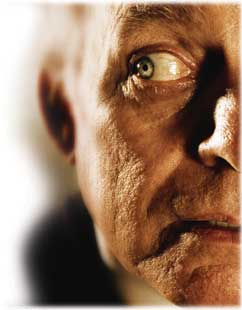
Vol. 77, No. 5, May
2004
Hearsay and the Confrontation Clause
The practice of courts admitting hearsay evidence under a reliability
test has been abruptly stopped by the U.S. Supreme Court. In Crawford v.
Washington, the Court held that, regardless of reliability, the historic
roots of the Sixth Amendment require that defendants be given an
opportunity to cross examine out-of-court statements that are
"testimonial" in nature.
 by Steven M. Biskupic
by Steven M. Biskupic
The rules of evidence may provide the basic framework for admission
of trial testimony, but the U.S. Supreme Court has issued a strong
reminder that the constitutional underpinnings of trial testimony should
not be ignored and, more importantly, cannot be trumped. In March 2004,
the Court in Crawford v. Washington overturned legal precedent
that had been used in Wisconsin state and federal criminal cases to
admit certain hearsay statements under a reliability test.1 The Court held that regardless of reliability, the
Sixth Amendment mandates that an accused has the right to cross examine
any witness whose out-of-court statement is "testimonial" in nature.
If no opportunity for cross-examination has taken place, the
statement cannot be admitted. With reference to an infamous English case
of 1603, the new decision essentially overrules lower court reliance on
a 1980 U.S. Supreme Court decision that placed emphasis on reliability
as the controlling factor.2 Instead, the
right to cross examine is paramount.
This article reviews the issues involved in the Supreme Court's
decision, the prior precedent as applied in two Wisconsin cases, and the
new rule's effect on future criminal cases in both state and federal
courts.
Hearsay, the Sixth Amendment, and Reliability
Hearsay is an out-of-court statement "offered in evidence to prove
the truth of the matter asserted."3 Although
hearsay is generally prohibited under the rules of evidence, most
litigators know that those same rules provide numerous exceptions.
Prior statements of witnesses, coconspirator statements, recorded
recollections, business records, statements against interest - these are
just a few of the many hearsay exceptions routinely applied in
court.4
The rules also provide a catch-all - or "residual exception" - that
allows the admission of hearsay not specifically covered by the rules,
if the hearsay evidence would "serve the general purposes of the rules"
and "provide equivalent circumstantial guarantees of
trustworthiness."5 Combined, these rules
allow for the routine admission of statements made by persons other than
those testifying at trial.
The Sixth Amendment, however, provides that "in all criminal
prosecutions, the accused shall enjoy the right ... to be confronted
with the witnesses against him." In other words, a criminal defendant is
afforded the right to confront, through cross-examination, those making
statements against him or her.
The intersection of the Sixth Amendment and the hearsay rules has not
been one of absolute contrast. Despite a witness being unavailable for
face-to-face courtroom confrontation, the courts have found no
constitutional violation if: 1) the witness was genuinely unavailable;
and 2) the statement has "adequate indicia of reliability."6
"Reliability" has been the subject of its own test. Under both
federal and state standards, reliability has been judged to depend on
affirmative answers to at least two questions: 1) does the evidence
support that the out-of-court witness actually made the statement; and
2) was the substance of the statement inherently trustworthy?7 Other decisions have added a third question: was
the hearsay exception at issue firmly rooted in criminal
practice?8
Accomplice Statements
Perhaps the most significant application of these standards in
criminal cases is the admission of out-of-court statements of an alleged
accomplice implicating the person who is on trial. Two Wisconsin cases,
one state and one federal, provide examples.
In State v. Bintz,9 the
defendant, Robert Bintz, was one of two brothers accused of the
first-degree murder of a Green Bay bartender. The other brother, David,
had admitted to police (and a cell mate) that he and Robert had
committed the murder. Tried separately, both brothers were convicted, in
part, on the basis of David's admission.
On appeal, Robert challenged the admission of David's prior
out-of-court statement. The court upheld the admission of the statement
in Robert's trial. The court found that under the hearsay rules, because
David had invoked his Fifth Amendment right against self-incrimination,
David was "unavailable" as a witness in Robert's trial. This finding
permitted the admission of David's statement as one against the penal
interest of the declarant, a recognized hearsay exception.10 In essence, because David was admitting to a
heinous crime, the statement, which also implicated Robert, was
admissible as evidence. The Sixth Amendment analysis was separate, but
flowed from this same framework. David's statement met the test of
inherent reliability because the declarant was admitting to a serious
crime.
A similar analysis was done in federal court in United States v.
Seavoy,11 a case involving two
brothers who were accused of robbing a bank in Pembine in far
northeastern Wisconsin. One brother, Robert, had pled guilty. At the
hearing to accept his guilty plea, Robert, under oath, told the district
court that he and his brother Ronald had committed the armed
robbery.
At Ronald's trial, however, Robert refused to testify. The judge in
Ronald's trial then allowed prosecutors to introduce Robert's testimony
from his guilty plea hearing, and Ronald was convicted as well.
On appeal, the Seventh Circuit Court of Appeals upheld the use of the
guilty plea transcript of Robert's statement. The court found that the
prior testimony of an unavailable witness met the requirements of
trustworthiness and reliability under both the residual hearsay
exception and the requirements of the Sixth Amendment. The statement was
made under oath and in the presence of a judge, was against the
declarant's penal interest, reflected personal knowledge, and was amply
corroborated by the other evidence presented at trial.
In both of these cases, the defendants were convicted based, in part,
on the out-of-court statement of an accomplice who did not testify at
trial.
Crawford and Precedent from 1603
The U.S. Supreme Court's most recent analysis of hearsay and the
Sixth Amendment also arose from a case involving family members as
potential accomplices.12 Michael Crawford
was accused of stabbing a man who allegedly tried to rape Crawford's
wife. The wife gave a statement to police officers, and the officers
taped the statement. She admitted being present when her husband stabbed
the man and she called into question whether her husband was acting in
self-defense. At trial, the wife's in-court testimony was excluded under
the state marital privilege, which prohibits one spouse from testifying
against the other without the other spouse's consent. Her prior recorded
statement, however, was admitted as permissible hearsay as a statement
against penal interest. Based in part on that evidence, the husband was
convicted.
In a 7-2 decision, the U.S. Supreme Court reversed the conviction.
Writing for the majority, Justice Scalia held that the reliability test
could not usurp the fundamental purpose of the Sixth Amendment: that is,
allowing a defendant to confront an accuser.
Much of the decision traces the historical underpinnings of the Sixth
Amendment. Of particular importance, according to the Court, was the
1603 English treason trial of Sir Walter Raleigh. He was convicted and
put to death on the basis of an out-of-court accomplice statement
obtained by the Crown. Raleigh was never permitted a face-to-face
confrontation of his accuser. His death provoked outrage at the
fundamental unfairness of convicting a person based on such
evidence.
This and other historical precedent led the Framers to insist on a
right of confrontation in criminal trials. Said Scalia, "The Sixth
Amendment must be interpreted with this focus in mind."13
The question for the Court, then, was not the inherent reliability of
a statement, but whether a defendant had the ability to challenge,
through cross-examination, the substance of what would otherwise be
considered testimonial evidence. Witness statements taken by police
officers or judges, whether sworn or not, were the precise type of
"testimonial" evidence underlying the Sixth Amendment's concern with the
right of confrontation.14
Besides relying on the historical underpinnings of the Sixth
Amendment, the decision also challenged the wisdom and consistency of a
constitutional framework based on "reliability." According to the Court,
"Reliability is an amorphous, if not entirely subjective concept. There
are countless factors bearing on whether a statement is reliable... By
replacing categorical constitutional guarantees with open-ended
balancing tests, we do violence to [the Framers'] design."15
If testimonial evidence is at issue, the defendant on trial must have
(or previously have had) an opportunity for cross-examination of the
witness providing that evidence.
"Testimonial" Evidence
The future significance of Crawford rests on the definition
of "testimonial" evidence. The Supreme Court decision explicitly refused
to provide a definition, but said that "at a minimum" the term includes
police interrogations and testimony at a preliminary hearing, before a
grand jury, or at a prior trial.16 Given
that holding, an accomplice statement that is either recorded by a
police officer or taken under oath by a judge likely will not be
admissible without the accomplice's in-court testimony, unless the
defendant had a prior opportunity for cross-examination.
 Steven M.
Biskupic, Marquette 1987, has been a prosecutor in the U.S.
Attorney's Office in Milwaukee since 1989. From 1987 to 1989, he was a
law clerk for the late Chief Federal Judge Robert W. Warren. Biskupic's
views do not necessarily reflect the official position of the U.S.
Department of Justice.
Steven M.
Biskupic, Marquette 1987, has been a prosecutor in the U.S.
Attorney's Office in Milwaukee since 1989. From 1987 to 1989, he was a
law clerk for the late Chief Federal Judge Robert W. Warren. Biskupic's
views do not necessarily reflect the official position of the U.S.
Department of Justice.
At the same time, however, the Crawford decision's reliance
on "testimonial" evidence explicitly left open flexibility (including a
reliability test) for the use of nontestimonial hearsay evidence. This
type of evidence, according to the Court, did not implicate core Sixth
Amendment concerns and should be more freely admitted at trial. The
Court cited business records and coconspirator statements as two hearsay
exceptions that do not involve testimonial evidence and thus do not
require the Sixth Amendment right of confrontation.17
The reference to business records gives support to other existing
hearsay exceptions on prior writings or recordings, such as recorded
recollections, medical records, and public documents. The coconspirator
statements are akin to, and based on, prior statements of the defendant
or the defendant's agent.18 These also
should be unaffected. In addition, the Crawford decision itself
raised, but did not decide, whether dying declarations are an exception
inherent in the Sixth Amendment.19
Conclusion
The rules of evidence provide flexibility in judicial determinations
about what evidence should be admitted at trial. Issues regarding
hearsay can be considered under concepts of trustworthiness and
reliability. But only to a point. Evidence that meets the hearsay rule
must still satisfy the Sixth Amendment requirement that a defendant be
allowed to confront an accuser. If an accuser's out-of-court statement
is testimonial in nature, the statement must be excluded unless the
defendant has been provided an opportunity for cross-examination.
Endnotes
1Crawford v. Washington,
124 S. Ct. 1354 (2004).
2See id. at 1359 (citing
Ohio v. Roberts, 448 U.S. 56 (1980)).
3Fed. R. Evid. 801(c). The
companion Wisconsin rules of evidence are at Wis. Stat. section 908.
Because of the author's familiarity with the federal rules, citations
are generally to that source.
4Fed. R. Evid. 803, 804.
5Fed. R. Evid. 807.
6See, e.g., Ohio v.
Roberts, 448 U.S. 56 (1980); United States v. Seavoy, 995
F.2d 1414, 1420 (7th Cir. 1993).
7Id.
8State v. Bintz, 2002 WI
App 204, 257 Wis. 2d 177, 183-84, 650 N.W.2d 913, 916.
9Id.
10See Fed. R. Evid.
804(b)(3).
11Seavoy, 995 F.2d
1414.
12Crawford, 124 S. Ct.
1354.
13Id. at 1363.
14Id. at 1366-67.
15Id. at 1371, 1373.
16Id. at 1374.
17Id. at 1367.
18Id. at 1377
(Rehnquist, C.J., dissenting).
19Id. at 1367 n.6.
Wisconsin
Lawyer
